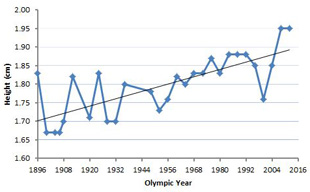 Thomas Burke, the first Men's 100m winner at the Olympic Games, ran the final in 12.0 seconds. Since the Men's 100m sprint was first contested at the Olympic Games, the level of sprinters has increased dramatically. Today, many regional-level U14 athletes would have been crowned Olympic champion in 1896.
Thomas Burke, the first Men's 100m winner at the Olympic Games, ran the final in 12.0 seconds. Since the Men's 100m sprint was first contested at the Olympic Games, the level of sprinters has increased dramatically. Today, many regional-level U14 athletes would have been crowned Olympic champion in 1896.Athletes have become taller and more muscular, as the science involved in sprinting has advanced. Sprinters have also specialised more in one event. For example, Jesse Owens won the 100m, 200m, the long jump, and was part of the winning team in the 4 by 100m. In his 100m final, his time was 10.3 seconds. However, athletes today rarely compete in both track and field events. Specialisation allows athletes to adapt their physical features to increase their performance in their chosen sport. Even in business and economics, Adam Smith noted that specialisation in pin-making increased production. A worker who has specialised in making the head of a pin makes the manufacture of the whole pin more efficient. The same principle applies to track and field teams.
Sprinting requires great flexibility and explosive power over short distances, requiring the levels of muscle mass typically found in the mesomorph somatotype. Because sprinting consists of rapid movement over short distances, excess mass is usually not a major problem.
Skeletal muscle fibres also play a large role. There are two types of muscles fibre: fast-twitch, which are more common amongst sprinters and slow-twitch, which are ideal for marathoners. The former fatigue far quicker than the latter, but are used for short, high-intensity bursts of energy. In order to develop more fast-twitch fibres, sprinters may lift heavier weights for fewer repetitions to increase explosiveness.
Comments
Post a Comment